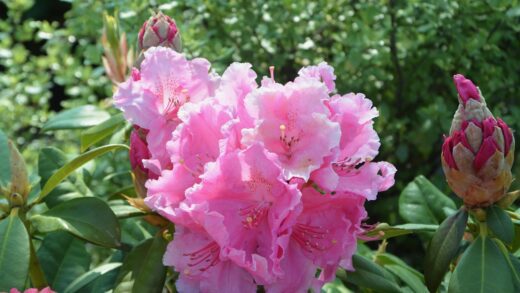The laurustinus is celebrated for its ability to brighten the darkest months of the year with its delicate flowers, a true testament to its resilience in the face of cold. However, successfully overwintering this evergreen shrub, particularly in colder climates or when grown in containers, requires a degree of thoughtful preparation. Understanding its limits of hardiness and taking proactive steps to protect it from the harshest winter elements will ensure that it not only survives the cold but emerges in spring healthy, undamaged, and ready for a new season of growth. Proper overwintering is about mitigating the specific challenges that winter presents, from frozen soil to desiccating winds.
The hardiness of laurustinus is generally rated for USDA zones 7 to 10, meaning it can typically withstand minimum winter temperatures down to about -12 to -15 degrees Celsius. However, this is not an absolute guarantee, as other factors can significantly influence its ability to survive the cold. The age and health of the plant, its location in the garden, the duration of the cold spell, and the presence or absence of snow cover all play a role. A young, newly planted shrub will be more vulnerable than a mature, well-established specimen with a deep root system.
One of the greatest winter threats to evergreens like laurustinus is not just the cold temperature itself, but the combination of frozen ground and winter sun or wind. When the ground is frozen solid, the plant’s roots are unable to absorb water. However, on a sunny or windy winter day, the evergreen leaves continue to lose moisture through transpiration. This imbalance, where the plant is losing water that it cannot replace, leads to dehydration and results in the browning and drying of the foliage, a condition commonly known as winter burn or desiccation.
The specific microclimate of your garden can also make a significant difference. A plant situated in a sheltered spot, such as against a south-facing wall or protected by other larger plants, will be in a much better position to handle the cold than one that is exposed to the full force of a cold north wind. Snow cover can also be beneficial, acting as a natural insulator for the root system and the base of the plant, protecting it from the coldest air temperatures.
Preparing garden plants for the cold
For laurustinus planted in the ground within their recommended hardiness zones, preparation for winter is relatively straightforward but still important for ensuring they look their best come spring. The focus is on protecting the root system, which is the most critical part of the plant for its long-term survival, and minimizing the risk of winter burn to the foliage. These preparatory steps should ideally be taken in mid to late autumn, before the first hard freeze is expected.
More articles on this topic
One of the most effective ways to protect the roots from deep freezing and temperature fluctuations is to apply a thick layer of mulch around the base of the plant. After the first light frost but before the ground freezes solid, spread a three- to four-inch layer of organic material, such as wood chips, shredded bark, or straw, over the root zone. This layer of mulch acts like a blanket, insulating the soil and helping to maintain a more stable temperature, which reduces the stress on the roots. Be sure to keep the mulch a few inches away from the trunk of the shrub to prevent rot.
Ensuring the plant is well-hydrated before the ground freezes is another crucial step. If autumn has been dry, provide your laurustinus with a few deep, thorough waterings in the weeks leading up to the first expected freeze. This ensures that the plant goes into winter with adequate moisture reserves in its tissues and in the surrounding soil. A well-hydrated plant is much more resilient and less susceptible to the damaging effects of winter desiccation than one that is already suffering from drought stress.
In locations that are on the colder edge of the plant’s hardiness range or in gardens that are particularly exposed to harsh winter winds, providing a physical windbreak can be very beneficial. This can be achieved by erecting a temporary screen made of burlap or horticultural fleece on the windward side of the shrub. This screen helps to deflect the worst of the cold, drying winds, creating a more sheltered microclimate and significantly reducing the risk of winter burn on the evergreen foliage.
Overwintering container-grown specimens
Plants grown in containers are far more vulnerable to winter cold than their counterparts in the ground. The soil in a pot does not have the vast insulating mass of the earth around it, meaning the roots are exposed to the ambient air temperature on all sides. In a cold snap, the soil in a container can freeze solid very quickly, which can kill the roots and, consequently, the entire plant. Therefore, special measures must be taken to protect container-grown laurustinus during the winter months.
More articles on this topic
The ideal solution for overwintering a potted laurustinus is to move it to a sheltered location that offers protection from the worst of the cold. An unheated garage, a cold greenhouse, or a protected porch where temperatures remain cool but stay consistently above freezing is perfect. The goal is not to keep the plant warm, as it needs a period of winter chill, but simply to protect its root system from freezing solid. The location should still offer some bright, indirect light if possible.
If you do not have a suitable indoor space, you can still provide a significant amount of protection outdoors. Move the pot to the most sheltered spot you have, such as against the wall of the house and out of the prevailing wind. You can then insulate the pot itself by wrapping it in layers of bubble wrap, burlap, or old blankets. Another effective technique is to place the pot inside a larger container and stuff the gap between the two pots with insulating materials like straw or shredded leaves.
For larger containers that are too heavy to move, you can group them together with other pots in a sheltered location. Huddling the pots together reduces the surface area of each pot that is exposed to the cold air. You can then pile insulating materials like leaves or straw up around the cluster of pots and wrap the entire group with burlap. Watering should be reduced significantly during the winter, but do not allow the compost to dry out completely. Check it every few weeks and water sparingly only when needed.
Recognizing and managing winter damage
Despite your best efforts, a particularly harsh winter can sometimes cause a degree of damage to your laurustinus. Being able to recognize this damage and knowing how to respond in the spring is important for helping the plant to recover quickly and return to good health. The most common form of winter damage is leaf browning or winter burn, but in severe cases, you may also see dieback of entire branches.
Winter burn, caused by dehydration, will appear as brown, dry, and brittle leaves, often on the side of the plant that was most exposed to the winter wind or sun. While it can look alarming, this damage is often purely cosmetic and does not necessarily mean the branch itself is dead. The best course of action is to be patient and wait until new growth begins to emerge in the spring before taking any action. Do not be tempted to prune out the damaged foliage during a winter thaw, as this can stimulate new growth that will be killed by the next frost.
Once spring arrives and the danger of hard frost has passed, you can assess the full extent of the damage. You will likely see new buds beginning to swell and break on the healthy parts of the branches. At this point, you can take a clean, sharp pair of secateurs and prune out any branches or tips of branches that are clearly dead and show no signs of new life. You can check if a branch is dead by scratching a small section of the bark with your thumbnail; if it is green underneath, it is still alive, but if it is brown and dry, it is dead.
After pruning away the deadwood, give the plant some supportive care to help it recover. Ensure it is well-watered as it begins its spring growth spurt and consider applying a balanced, slow-release fertilizer to provide the nutrients it needs to produce new foliage. In most cases, a healthy laurustinus will recover quickly from minor winter damage, and the flush of new spring growth will soon cover up any bare spots left by the pruning.


















